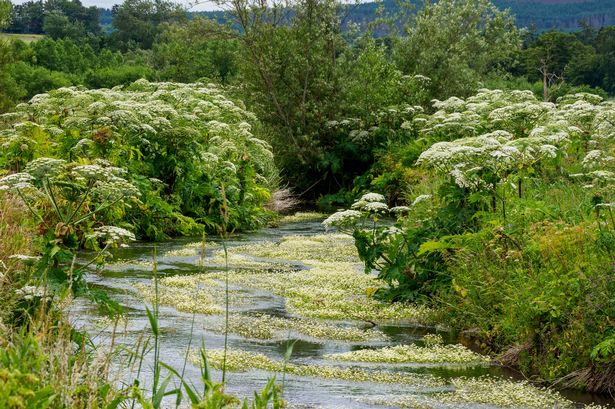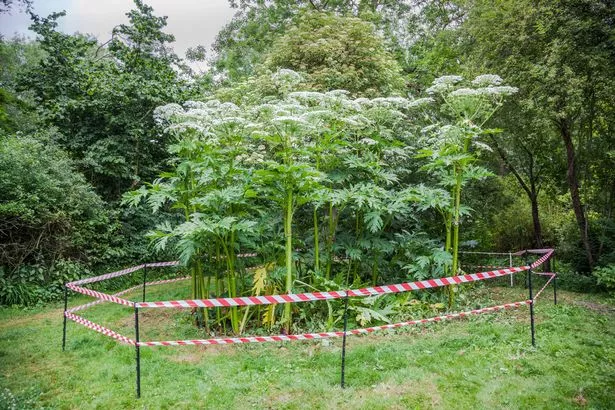An invasive plant specialist has warned there are four other weeds people should be looking out for in their gardens that can cause just as much trouble as Japanese knotweed Giant hogweed is ‘widespread’ in Ireland(Image: Gannet77 via Getty Images)
Giant hogweed is ‘widespread’ in Ireland(Image: Gannet77 via Getty Images)
Irish gardeners have been issued a warning about four invasive plant species – including one so dangerous it could cause blindness.
Japanese knotweed is often regarded as one of the most hazardous plants in the country. It can inflict severe structural damage to homes and concerns over its spread are so grave that failing to deal with it properly could result in imprisonment.
However, an invasive plant expert has now warned that there are four other weeds that people should be vigilant for in their gardens, which could cause just as much havoc.
Pauraic Larkin, a Knotweed Specialist at Japanese Knotweed Control LTD, identifies Giant hogweed as the worst offender.
Below, he elaborates on why each is detrimental to your garden and how to identify them, reports the Irish Mirror.
Giant hogweed
Pauraic explained: “Giant hogweed is dangerous and common. It’s also a human health hazard due to chemicals in the sap, which can blind or cause burns when exposed to UV light. It originates from the Caucasus Mountains at the border of Europe and Asia, but was brought to Ireland in the 19th Century as an ornamental garden plant.
“Since then, it has escaped into the wild and is scattered throughout the country and is now widespread in Ireland. Each plant can produce between 1,500 to 100,000 coin-sized, paper thin seeds – which disperse easily in rain and wind.”
How to spot it: Giant Hogweed leaves have coarse and serrated edges. The stem has very fine hairs which grow from red spots.
 Giant hogweed can cause burns or even blinding(Image: GETTY)Himalayan knotweed
Giant hogweed can cause burns or even blinding(Image: GETTY)Himalayan knotweed
“Himalayan knotweed is structurally damaging,” Pauraic explained. “It forms dense stands that outcompete native species, but die back in winter leaving areas vulnerable to erosion. It also displaces native species by forming dense stands up to 2m tall which reduce the availability of nutrients in the soil. Cutting the plant without proper site management could cause the plant to spread further.”
How to spot it: It has large lanceolate type leaves which often have a reddish mid-rib. It produces a small white flower and has a bamboo-like stem with red nodes.
Himalayan balsam
Pauraic went on to say: “Himalayan balsam is an alien invasive plant introduced to Ireland in the mid 19th Century, mainly by Victorian gardeners. It’s now abundant across Ireland. It outcompetes native species, as well as eroding riverbanks and clogging up rivers and streams which can lead to flooding.
“It’s difficult to control because it’s very difficult for people to chop down, but also because seeds keep arriving from neighbouring areas. Each plant can produce up to 1,500 seeds a year and their explosive pods can shoot seeds up to 7m away, which then stick to shoes and car tyres. Bees are also attracted to the flowers and can spread the seeds widely.”
How to spot it: It’s very tall and can grow to over three metres. It has bright pink flowers, with slender leaves.
Cherry laurel
“Cherry laurel is an alien invasive plant, meaning it out-competes crowds-out and displaces beneficial native plants that have been naturally growing in Ireland for centuries,” Pauraic explained. “Its rapid growth, coupled with its evergreen habit and its tolerance of drought and shade, often allow it to out-compete and kill off native plant species.
“It is spread by birds, through the seeds in their droppings. Cherry Laurel is poisonous as its leaves and seeds contain toxic compounds, including hydrocyanic acid (cyanide), and should not be ingested by humans or animals. Seeds, similar to those of apricots and peaches, are dangerous and should not be eaten. Handling cherry laurel requires care, as ingestion can cause serious complications.”
How to spot it: The leaves are dark green and look leathery and shiny. They’re typically between five and 30cm long, and 4-10cm broad. The fruit is a small cherry, which turns black when ripe and smells like almonds – but can be extremely harmful to humans if eaten.


Comments are closed.